Crime statistics
Data extracted in April 2023
Planned article update: 24 April 2024
Highlights
Sexual violence offences are still in an increasing trend in 2021.
Robbery, burglary and theft, 2010-2021
The statistics presented in this article are based on official figures for police-recorded offences (criminal acts) in Europe between 2008 and 2021. The results cover the European Union (EU), the EFTA countries, as well as the candidate countries and the potential candidate countries. The number of police-recorded crimes varies widely across the EU, even relative to population size, due to different laws, recording practices and reporting to the police, that affect comparison. The crimes are classified according to the ICCS (International Classification of Crime for Statistical Purposes). Counting methodologies for offences and persons should be applied. Countries' compliance with the classification of crimes and counting methodologies is explained in the general and countries metadata and in the police-recorded offences metadata.
Full article
3 690 intentional homicides in the EU in 2021, the lowest value in 2008-2021
After a slight increase in 2020, there were 3 690 police-recorded intentional homicides in 2021 in the EU, with a 4.3 % decrease compared to the previous year. The decrease was observed in 16 EU countries out of 27 that provided data. Figure 1 shows the absolute number and the rate per hundred thousand inhabitants.

(number of police-recorded offences and rate per 100 000 inhabitants)
Source: Eurostat (crim_off_cat)
Women victims of intentional homicide killed by family members or intimate partners (per million women) were 3.9 in 2021 while male victims were 1.8 (per million men)
As shown in Figure 2, the rate of women killed by family members or intimate partners in relation to the population size decreased in 2021 compared to previous year. Looking at the figures per million of women, the rate decreased by 7 % from 4.2 to 3.9 and returned to the 2019 level. At the same time, men killed by family members or intimate partners decreased by 17 % (1.8 per million men compared to 2.2 in the previous year). The values are calculated on the responding countries, covering between 75 % and 82 % of the EU population in the period 2015-2021.
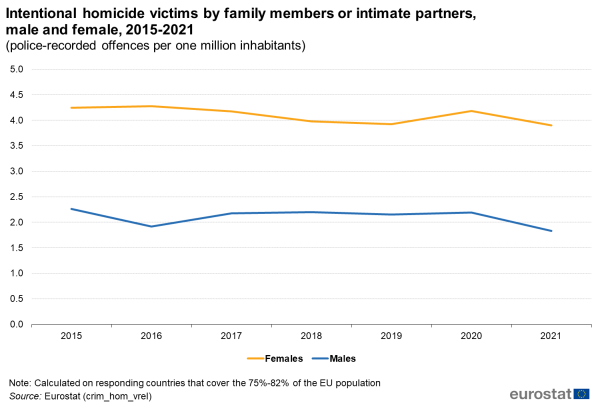
Source: Eurostat (crim_hom_vrel)
About 206 800 sexual violence crimes in the EU in 2021, still on a growing trend
In the EU, about 206 800 offences of sexual violence were recorded by police in 2021, that is 17 % more than in the previous year. As shown in Figure 3, the trend had increased since 2013, with the exception of 2020. There was an increase in the number of sexual violence offences in 2021 compared to 2020 in 24 out of 27 countries, while Bulgaria, Hungary and Slovakia are the only countries to record a decrease. In 2021, in the EU countries, the police recorded 46 offences of sexual violence per 100 000 inhabitants, compared to 39 in 2021.
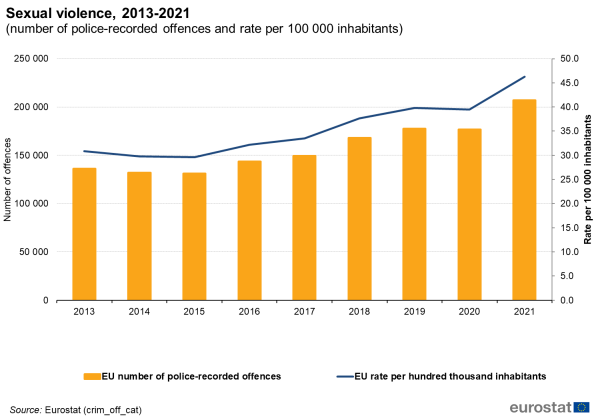
(number of police-recorded offences and rate per 100 000 inhabitants)
Source: Eurostat (crim_off_cat)
216 400 robberies, 1 200 300 burglaries and 4 362 000 thefts in the EU in 2021, the lowest numbers since 2010
Between 2020 and 2021, police-recorded robberies in the EU fell by 1 %, to around 216 400. Robberies have been continuously decreasing since 2013 and had a sharp decline in 2020. They further decreased in 23 out of 27 countries in 2021, with the exception of Estonia, Spain, Italy and Luxembourg. In 2021, 48 robberies were recorded by the police for every 100 000 inhabitants in the EU countries, a small decrease (- 1) compared with 49 in 2020. In the EU, police-recorded burglaries amounted to around 1 200 300 in 2021. As shown in Figure 4, the number of robberies was generally steady until 2014 and has declined since then. The number of burglaries decreased by 7 % compared to 2020 and is 44 % smaller than the highest value reached in 2014[1]. Comparing the EU countries that provided data in 2021, 19 countries out of 25 reported the lowest value for the 2010-2021 period. There was a decrease in the number of burglaries from the previous year in 21 countries out of 25 that provided the data for both years, while Czechia, Italy, Luxembourg and Romania registered an increase. Two hundred and sixty nine burglaries were recorded by police for every 100 000 inhabitants in the EU countries in 2021, a decrease (- 31) compared to 290 in 2020. Police-recorded thefts numbered around 4 362 000 in 2021, with a 2 % decrease compared to 2020. As shown in Figure 4, there was an increase until 2014, followed by a decrease since then. This decrease was partly caused by a methodological break in the French series in 2016, due to a change in classification to better comply with ICCS (International Classification of Crime for Statistical Purposes). In 2021, 17 countries out of 27 registered the lowest value for the period 2010-2021. In 18 countries out of 27 there was a decrease in the number of thefts compared to the previous year, while the values increased in Belgium, Estonia, Spain, France, Italy, Cyprus, Luxembourg, Poland, Romania. In 2021, 975 thefts were recorded by the police for every 100 000 inhabitants in the EU countries, a decrease (- 17) compared with 992 in 2020.
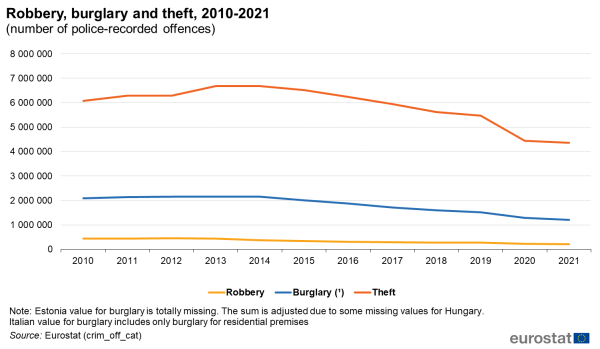
(number of police-recorded offences)
Source: Eurostat (crim_off_cat)
Figure 5 shows the sum of robberies, burglaries and thefts in 2021 in relation to the population size (police-recorded offences per 100 000 inhabitants) and compared with the previous year. The highest figures for police-recorded offences in 2021 were observed in Sweden (3 558 per 100 000 inhabitants that means one offence per 28 persons), Denmark (2 677 per 100 000 inhabitants, one offence per 37 persons) and Finland (2 392 per 100 000 inhabitants, one per 42 persons), Luxembourg (2 301 per 100 000 inhabitants, one per 43 persons) and France (2 268 per 100 000 inhabitants, one per 44 persons), followed by seven countries with between 1 000 and 2 000 robberies, burglaries and thefts per 100 000 inhabitants (Belgium, Italy, Germany, Netherlands, Austria, Ireland and Malta), equivalent to one per 50-100 people. In eight countries the rate was between 500 and 1 000 police-recorded robberies, burglaries and thefts per 100 000 inhabitants, one every 100-200 persons, and in Poland, Croatia, Hungary, Bulgaria, Lithuania, Slovakia and Cyprus the rate was below 500 per 100 000 inhabitants, one for over 200 people. The differences among countries are explained not only by the level of crime, but also by the different attitudes in reporting and recording crimes, especially minor ones.
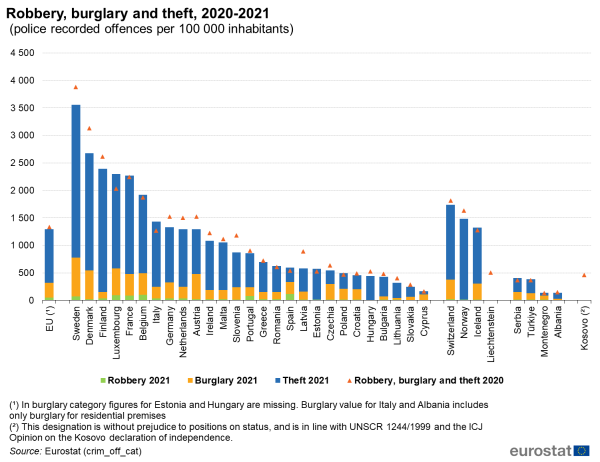
(police-recorded offences per 100 000 inhabitants)
Source: Eurostat (crim_off_cat)
Frauds are on an increasing trend since 2016
In the EU there were around 2 450 800 police-recorded frauds in 2020, the last collected year, with an increase of 4 % compared to the previous year. Fourteen out of 26 countries that provided the data had an increase compared to 2019 and 12 countries recorded their highest value for the 2016-2020 period. This category also includes cyber-related frauds.
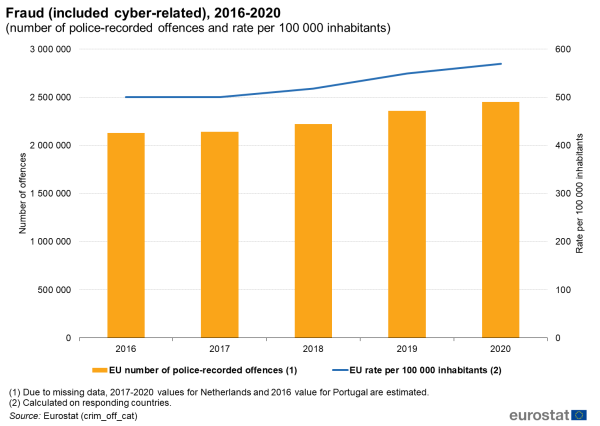
Source: Eurostat (crim_off_cat)
Source data for tables and graphs
Data sources
Statistics on crime and criminal justice systems in general
Data sources include police and other law enforcement agencies, public prosecutors, law courts, prisons, relevant ministries, and statistical offices. The national authorities are responsible for official figures that are sent to Eurostat and to the United Nations (UN Survey on Crime Trends and Operations of Criminal Justice Systems).
The data of this article
This article presents results based on official figures for police-recorded offences (criminal acts) from 2008 onwards. Eurostat updates the web database when countries send new figures, which may differ from figures presented in previous web articles. A major problem for crime statistics at European level is missing figures. Several EU totals in this article were adjusted due to this. For instance if a 2021 figure was missing, the figure for 2020 was used from same country for the same crime. In some cases, an average of the year before and after is used. Another method to deal with missing data is to compare three-year averages. For some crimes, simply too much data are missing for an EU total to be presented. The web database contains figures as reported (no adjustment).
Particular crimes
Additional data on intentional homicide, rape, and sexual assault:
Earlier data
Context
Crime statistics are used by EU institutions, national authorities, media, politicians, organisations, and the general public. Each state establishes its criminal laws, define crimes, legal proceedings and justice reactions, as well as specifications for official crime statistics (except for crimes that are covered by international or EU law). Typically, comparing crime statistics between countries is challenging due to different national criminal laws and different criminal justice systems.
However, it could also be argued that there are many similarities between European countries. This, combined with public and political interest, was the background for developing EU-wide crime statistics. Over the last decade, EU institutions, national authorities, and the UN have cooperated to improve European crime statistics. A major quality improvement is to use a common classification of crimes.
Official crime statistics mainly reflect how the authorities register and handle cases. The figures are provided by national authorities such as the police, prosecution, courts, and prisons. Of those, police figures give the broadest picture, as they include recorded offences, whether or not they led to prosecution. Still, the police records do not measure the total occurrence of crime. Simply put, the total occurrence would be the reported plus the unreported, minus the incorrectly reported. It is fair to assume that the reporting rate is high when a police record is required to support an insurance claim (e.g. car theft and burglary).
Direct access to
Notes
- ↑ In the EU total, the value for Estonia is missing and the Hungarian values for 2016-2021 are based on the latest available figures due to missing data.